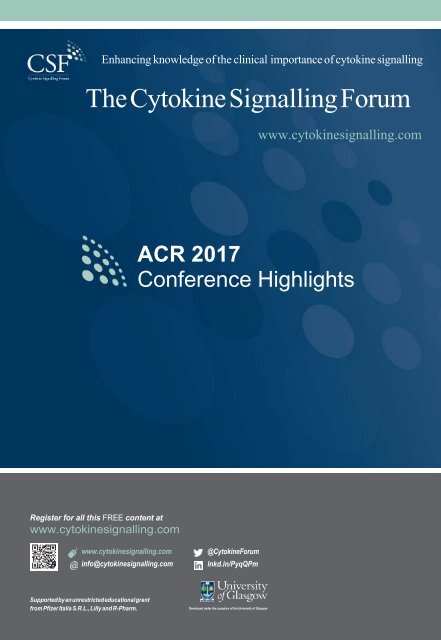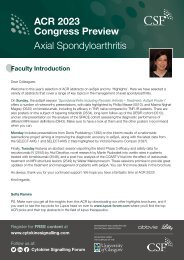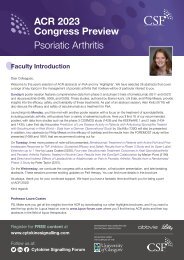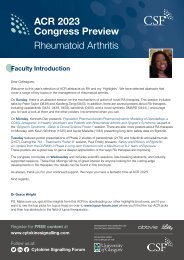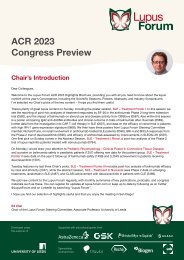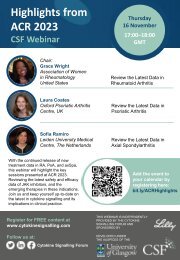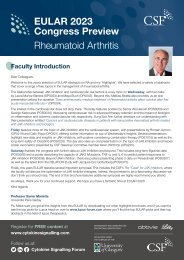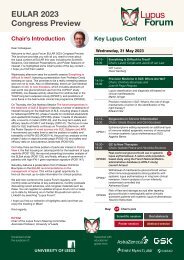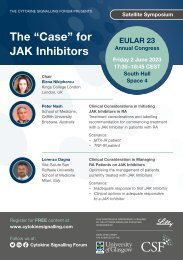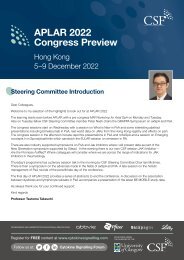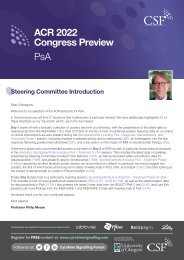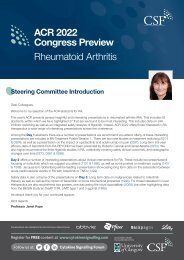ACR 2017 Review
Create successful ePaper yourself
Turn your PDF publications into a flip-book with our unique Google optimized e-Paper software.
Enhancing knowledge of the clinical importance of cytokine signalling<br />
The Cytokine Signalling Forum<br />
www.cytokinesignalling.com<br />
<strong>ACR</strong> <strong>2017</strong><br />
Conference Highlights
<strong>ACR</strong> <strong>2017</strong><br />
Conference Highlights<br />
Chairman’s Welcome<br />
Dear CSF Member,<br />
It is my pleasure to once again bring to you our review of the <strong>ACR</strong> <strong>2017</strong> highlights, including a review of my ‘Chairman’s picks’ – those<br />
abstracts, which I feel were the most significant at this year’s congress.<br />
New molecules of interest continue to be developed, and this year sees the release of Phase 3 data from upadacitinib (previously<br />
known as ABT-494), a selective JAK-1 inhibitor – Burmester, et al. share the results of this study in 661 patients with RA with an<br />
inadequate response to csDMARDs [#1904].<br />
Long-term data for tofacitinib out to 9 years are presented [#522] along with the effect of dose escalation or de-escalation on efficacy<br />
and safety in these long-term extension studies [#535]. Results from the Phase 3b/4 ORAL Strategy trial compare patient-reported<br />
outcomes (PROs) in 1146 patients with RA receiving tofacitinib ± methotrexate versus adalimumab ± methotrexate [#1906]. Specific<br />
considerations with tofacitinib treatment include look at the effectiveness of live zoster vaccine in patients with RA subsequently initiated<br />
on tofacitinib 2–3 weeks later [#1440].<br />
Tofacitinib is also examined in non-RA indications, with a pooled analysis of PROs in 430 patients with psoriasis and psoriatic arthritis<br />
(PsA) from the OPT Pivotal studies [#613], as well as an integrated safety analysis [#616] and efficacy analysis [#619] from the OPAL<br />
trials in PsA.<br />
Baricitinib continues to publish extensive data, with an update to the integrated safety analysis out to 5.5 years in RA [#511] and results<br />
from a prospective study suggesting that dose reduction is possible in patients achieving sustained disease control [#1821]. Vaccine<br />
response is also examined by Winthrop, et al., with an evaluation of pneumococcal and tetanus vaccination in 106 patients with RA<br />
receiving baricitinib in RA-BEYOND [#1824].<br />
In the IL-6 field, abstracts on tocilizumab focus on long-term safety in post-marketing studies [#550] and sustained response following a<br />
switch from methotrexate + tocilizumab [#1905]. PROs following withdrawal of methotrexate are also investigated [#2460].<br />
The following pages provide a review of the highlights from <strong>ACR</strong> <strong>2017</strong>, including my ‘Chairman’s picks’. Once again, thank you for your<br />
support, and we hope you enjoyed your time at <strong>ACR</strong> <strong>2017</strong>.<br />
Yours,<br />
Prof. Iain McInnes
Highlights from <strong>ACR</strong> <strong>2017</strong><br />
.<br />
During the <strong>ACR</strong> <strong>2017</strong> annual meeting, many presentations and posters reported on<br />
cytokine signalling and related drugs. This document reviews the highlights.<br />
<strong>ACR</strong> poster session A<br />
Rheumatoid Arthritis – Small Molecules, Biologics and Gene Therapy Poster I:<br />
Comorbidities and Adverse Events; Efficacy and Safety of Small Molecules<br />
Upadacitinib patient-reported outcomes; and long-term data<br />
Strand, et al. presented patient-reported outcomes (PROs) with upadacitinib (previously<br />
known as ABT-494), a selective JAK inhibitor. In this Phase 2 open-label extension study,<br />
493 patients received upadacitinib. At Week 48, patients in all cohorts reported<br />
improvements across all PROs, including disease activity, pain, physical functioning,<br />
fatigue, work functioning, and overall health status. The largest improvements were seen<br />
in patients who did not titrate their dose either up or down during the trial [#501].<br />
Long-term safety and efficacy of upadacitinib in BALANCE-EXTEND, an ongoing,<br />
combined open-label extension (OLE) of the Phase 2 trials was reported in a poster from<br />
Genovese, et al. The event rate for AEs seen in the OLE was lower than in the Phase 2<br />
trials, and overall events per 100 patient-years were 2.3 for serious infection, 3.7 for<br />
herpes zoster, 0.8 for malignancies excluding non-melanoma skin cancer, and 1.0 for<br />
adjudicated cardiovascular (CV) events. There were 2 deaths. At Week 72, efficacy was<br />
maintained in patients on upadacitinib 6 mg BID; 55% of patients achieved <strong>ACR</strong>70 and<br />
83% were in low disease activity at the end of the observation period [#509].<br />
Filgotinib monotherapy; and the effect of MTX dose when used as combination therapy<br />
Taylor, et al. showed that filgotinib monotherapy was associated with significant reductions<br />
in a broad panel of immune- and tissue-related biomarkers relevant to RA, compared with<br />
placebo (27/35 markers). The largest reductions were in the pro-inflammatory markers IL-<br />
6, SAA, and CRP (58–68% median reduction from baseline to Week 12, P12.5 to
Baricitinib achievement of low disease activity; and patient-reported outcomes<br />
Baricitinib Phase 3 data from RA-BEAM was presented by Nash, et al. Treatment with<br />
baricitinib resulted in significantly lower mean disease activity at Weeks 12 and 24 than<br />
placebo (P
functional assessment of chronic illness therapy - fatigue (FACIT-F), SF-36 physical<br />
component score (PCS), and duration of morning joint stiffness at 4 weeks after rescue,<br />
and these improvements were sustained through 12 weeks [#508].<br />
Results of a systematic review and network meta-analysis, inferring from both direct and<br />
indirect evidence comparing baricitinib and tofacitinib, were presented by Zamora, et al.<br />
When comparing indirectly, the only differences were observed in favour of baricitinib +<br />
MTX compared with tofacitinib alone. All drug combinations were effective compared with<br />
placebo in reducing at least 50% of symptoms or achieving remission at 12 weeks.<br />
Tofacitinib 10 mg and baricitinib 8 mg combined with MTX were among the most<br />
efficacious options. SAEs were less likely with the tofacitinib groups, although the withinclass<br />
differences were small and may not be clinically meaningful [#531].<br />
Baricitinib and tofacitinib long-term safety<br />
Genovese, et al. presented the 5.5-year safety profile for baricitinib from an ongoing longterm<br />
extension (LTE). This included 3492 patients, with a total of 6637 patient-years of<br />
exposure. No differences were seen for baricitinib 4 mg versus placebo in AEs leading to<br />
permanent study drug discontinuation, death, malignancy, serious infection, or major<br />
adverse cardiovascular events (MACE). The incidence of herpes zoster (HZ) was<br />
significantly higher for baricitinib 4 mg versus placebo (4.3 versus 1.0, respectively).<br />
Malignancy (excluding non-melanoma skin cancer [NMSC]) incidence rates were 0.5 and<br />
1.3 for 2 mg and 4 mg, respectively, which are similar to those previously reported. The<br />
incidence of lymphoma (0.09), gastrointestinal perforation (0.05), and tuberculosis (0.15,<br />
all in endemic areas) were also similar to those previously reported. Fewer than 1% of<br />
patients discontinued due to abnormal laboratory results [#511].<br />
Wollenhaupt et al. presented the 9-year safety and efficacy data for tofacitinib. Data were<br />
taken from two ongoing OLEs in 4967 patients, with total tofacitinib exposure of 17,738.5<br />
patient-years. In total, 50.7% of patients discontinued; 23.9% due to AEs, and 3.6% due<br />
to insufficient clinical response (3.6%). The most common AE classes were infections and<br />
infestations (69.6%) and musculoskeletal/connective tissue disorders (40.3%). SAEs<br />
occurred in 29.4% of patients, and serious infection events (SIEs) in 8.9%. Malignancies,<br />
excluding NMSC, were reported in 3.0%. No new safety risks were identified, and clinical<br />
responses were sustained from Month 1 to Month 96 [#522].<br />
Clinical and structural responses of tofacitinib<br />
The efficacy of tofacitinib and predictive value of baseline markers of inflammation in<br />
patients with moderate to severe RA by baseline CRP and ESR was presented by<br />
Schwartzman, et al. using data from 4 Phase 2 trials. The pooled population included 2161<br />
patients in the csDMARD-IR group, and 512 patients in the bDMARD-IR group. In both<br />
dose groups, <strong>ACR</strong> response rates at Month 6 were generally numerically higher with<br />
higher baseline CRP for both csDMARD-IR and bDMARD-IR patients. A trend for greater<br />
improvement in disease activity was observed with higher baseline CRP but not with<br />
higher baseline ESR. The proportions with AEs, SAEs, serious infections, and<br />
discontinuations due to AEs were generally similar regardless of baseline CRP or ESR<br />
[#495].<br />
van der Heijde, et al presented 3-year radiographic data from an OLE in 1156 patients with<br />
RA. Mean change in mTSS was 0.25 at Month 12, and 1.17 at Month 36. Mean change in<br />
erosion score and joint space narrowing (JSN) were 0.21 and 0.24 at Month 12, and 0.68
and 0.78 at Month 36, respectively. The percentage of all tofacitinib-treated patients with<br />
radiographic non-progression decreased from 91.2% at Month 6, to 84.5% and 72.2% at<br />
Months 12 and 36, respectively. The percentage of patients with no new erosions<br />
decreased from 96.0% at Month 6, to 92.3% and 85.3% at Months 12 and 36, respectively.<br />
Similar trends were observed for all endpoints in the tofacitinib monotherapy and<br />
csDMARD treatment groups [#533].<br />
Gaylis, et al. discussed clinical and structural responses using step-up dosing of tofacitinib<br />
in a treat-to-target approach in 20 patients with active RA. Over a 12-week period,<br />
6 patients remained on 5 mg BID, and 14 dose-escalated to 10 mg BID. In the 5 mg group,<br />
3 patients completed the trial at target and 3 discontinued due to lack of efficacy,<br />
relocation and AE. Structurally, there was no change in erosions in this group. Of the 14<br />
dose-escalation patients, 11 completed the trial, with 7 remissions, 2 at LDA, and 1 at<br />
MDA; 3 patients discontinued due to lack of efficacy. In the 10 mg group, 9 patients<br />
showed no change in erosions, 1 regression and 1 progression. 5 patients showed no<br />
change in synovitis and 6 showed regression, and 7 showed no change in osteitis, 3<br />
showed regression and 1 showed progression. CRP values correlated with improvement<br />
of the clinical and structural results; the levels improved after the dose was increased to 10<br />
mg bid. Overall, the findings suggest that a significant number of patients treated with the<br />
standard dose of 5 mg bid may potentially have improved outcomes including LDA or<br />
remission when treated at a higher dose (10 mg bid) [#520].<br />
In a retrospective analysis of real-world data, Mueller, et al. showed that tofacitinib may<br />
induce high rates of LDA and remission in patients with active RA, even after use of one or<br />
more bDMARDs, over prolonged periods of time. In 58 patients treated with tofacitinib,<br />
86% had been pre-exposed to at least one bDMARD. Thirty-seven (63.8%) and 31(53.4%)<br />
patients achieved LDA or remission after 62.0 and 65.3 days, respectively [#536].<br />
Tocilizumab long-term data from large clinical trial and post-marketing populations<br />
Long-term data were presented for tocilizumab to provide an updated report on safety in<br />
patients with RA using data from multiple completed clinical trials and LTEs, as well as an<br />
from the global post-marketing safety database. The clinical trial all-exposure<br />
population included 7647 patients, constituting 22,394 patient-years of exposure. The<br />
overall rate of SAEs in the clinical trial population was 14.16 per 100 patient-years. Overall<br />
incidence rates for individual events for the clinical trial population were consistent in each<br />
6-month period over the 5-year duration. The global post-marketing population included<br />
606,937 patients. The overall spontaneous reporting rate of AEs of special interest in the<br />
post-marketing population was 9.37 per 100 patients. Reporting rates of individual safety<br />
events of interest were consistent in each 6-month period over the 7-year duration [#550].
Rheumatoid Arthritis – Small Molecules, Biologics and Gene Therapy II: Trials Therapy<br />
Updadacitinib Phase 3 results<br />
A poster from Burmester, et al. showcased Phase 3 results for upadacitinib in 661 patients<br />
with RA and inadequate response to csDMARDs. At Week 12, significantly more patients<br />
receiving upadacitinib 15 mg and 30 mg QD achieved an <strong>ACR</strong>20 response compared with<br />
placebo (63.8% and 66.2% vs 35.7%, P
Spondyloarthropathies and Psoriatic Arthritis – Clinical Aspects and Treatment Poster I<br />
Tofacitinib efficacy and safety in psoriatic arthritis<br />
Nash, et al. presented an integrated efficacy analysis from the Phase 3 studies OPAL<br />
Broaden and OPAL Beyond in 238, 236 and 236 PsA patients receiving tofacitinib 5 mg<br />
BID, 10 mg BID, or placebo, respectively. Significant improvements versus placebo at<br />
Month 3 were seen for peripheral arthritis and physical function endpoints for tofacitinib 5<br />
mg and 10 mg BID. Significant improvements in psoriasis, enthesitis, and dactylitis<br />
endpoints versus placebo were seen for tofacitinib 5 mg and 10 mg BID at Month 3, and<br />
efficacy was maintained or further improved at Month 6 [#619].<br />
Kivitz, et al. investigated pooled data from OPAL Broaden and OPAL Beyond, looking at<br />
the efficacy of tofacitinib by background MTX dose in patients with PsA. In total, data from<br />
556 patients who received tofacitinib plus MTX or placebo plus MTX (tofacitinib 5 mg BID,<br />
n=186; tofacitinib 10 mg BID, n=178; placebo, n=192) were included in this analysis. Most<br />
patients were treated with background MTX at doses ≤15 mg/week (66.7%; mean dose<br />
12.6 mg/week) compared with >15 mg/week (33.3%; mean dose 19.8 mg/week). At Month<br />
3, tofacitinib 5 and 10 mg BID were generally associated with numerically greater <strong>ACR</strong> and<br />
HAQ-DI response rates and greater changes from baseline in HAQ-DI score compared<br />
with placebo. The magnitude of tofacitinib effects on efficacy outcomes appeared broadly<br />
similar between background MTX dose groups [#615].<br />
Tofacitinib improvement of composite endpoint measures in PsA from OPAL Broaden and<br />
OPAL Beyond were presented by Helliwell, et al. The composite endpoints assessed were<br />
Psoriatic Arthritis Disease Activity Score (PASDAS), DAS28[CRP], Disease Activity Index<br />
for Reactive Arthritis/Psoriatic Arthritis (DAREA/DAPSA), and Composite Psoriatic Disease<br />
Activity Index score. Both doses of tofacitinib showed improvements in composite<br />
endpoints versus placebo at Month 3 in both studies. In OPAL Broaden, the effects of<br />
adalimumab were similar to both doses of tofacitinib across composite endpoints. The<br />
largest effect size and standardised response means were observed for PASDAS. Effect<br />
sizes and standardised response means varied across endpoints but were consistent<br />
across studies [#623].<br />
Data from the second interim analysis of OPAL Balance, an open-label LTE in 686<br />
patients with PsA was presented by Nash, et al. Mean duration of tofacitinib exposure in<br />
the LTE was 448 days. On Day 1, 98.5% of patients received a csDMARD, which was<br />
later discontinued by 8.3% of patients. To Month 36, 1685 AEs were reported in 502<br />
patients; 10.5% of patients had SAEs, and 7.6% discontinued due to AEs. AEs of special<br />
interest included 11 serious infections (1.6%), 19 HZ events (2.8%) including 1 serious<br />
event of facial HZ, 2 MACE (0.3%), and 13 (1.9%) malignancies. No AEs of<br />
gastrointestinal perforation or inflammatory bowel disease were reported. One AE of<br />
uveitis was reported. There were 4 deaths, but they were not attributed to treatment.<br />
Latent tuberculosis was reported in 4 patients whose previously negative QuantiFERON<br />
response became positive. Few patients experienced elevated liver enzyme levels.<br />
Overall, the safety profile of tofacitinib in active PsA was similar to that of the pivotal Phase<br />
3 studies. No new safety signals were identified, and efficacy across various disease<br />
domains was maintained over time [#620].<br />
In the same poster session, Burmester, et al. gave an integrated safety summary of<br />
tofacitinib in the Phase 3 studies OPAL Broaden and OPAL Beyond, and in 1 LTE study<br />
(OPAL Balance). Overall, tofacitinib in active PsA demonstrated a safety profile consistent
with that seen with tofacitinib in RA, and no new risks were identified. Nasopharyngitis<br />
(5.9%) and headache (8.5%) were the most commonly reported AEs at Month 3 in patients<br />
receiving tofacitinib 5 and 10 mg BID, respectively. Discontinuation due to AEs occurred in<br />
4.6% and 4.7% of patients, respectively. Across all tofacitinib-treated patients in the<br />
Phase 3 and LTE studies, serious infections occurred in 1.4%, and HZ was reported in<br />
2.0%. There were 2 deaths, both considered unrelated to the study drug. MACE was<br />
reported in 0.4%, malignancies (excluding NMSC) in 0.6%, and NMSC in 0.5% [#616].<br />
Effect of tofacitinib on patient-reported outcomes in psoriatic arthritis<br />
Strand, et al. presented the effect of tofacitinib on PROs in patients with active PsA in<br />
OPAL Beyond and OPAL Broaden. Improvements in PtGA and pain were observed as<br />
early as Week 2 and exceeded placebo at Month 3 with both tofacitinib doses (P≤0.05). At<br />
Month 3, SF-36v2 and FACIT-F scores exceeded placebo with both doses (P≤0.05), and<br />
improvements in PCS, physical functioning, bodily pain and FACIT-F exceeded minimal<br />
clinically important difference (MCID). PRO improvements reported in OPAL Broaden with<br />
tofacitinib were similar to adalimumab [#596].<br />
In an analysis reported by Bachelez, et al. 52-week data were pooled from the two OPT<br />
Pivotal studies of tofacitinib in patients with psoriasis and concomitant PsA. At Week 16 a<br />
greater proportion of patients achieved PASI75, PGA, and PtGA responses with tofacitinib<br />
5 and 10 mg BID versus placebo (all P
<strong>ACR</strong> Poster Session B<br />
Rheumatoid Arthritis – Small Molecules, Biologics and Gene Therapy Poster II:<br />
Prognostic Factors, Imaging and Miscellaneous Reports<br />
Effects of tofacitinib on zoster vaccine; and the effect of tofacitinib monotherapy on<br />
arterial stiffness<br />
Winthrop, et al. evaluated the long-term effectiveness of live zoster vaccine (LZV) in<br />
patients with RA by looking at the incidence of HZ after treatment with tofacitinib for up to<br />
27 months. In total, 112 patients received LZV and were randomised 2–3 weeks later to<br />
tofacitinib 5 mg BID or placebo for 12 weeks. HZ occurred in 5 cases, with an incidence<br />
rate per 100 patient-years of 3.60. Four cases were monodermatomal, and 1 case<br />
involved 5 dermatomes. All cases resolved with treatment. ELISPOT measures were<br />
undetectable at baseline and at Week 6 post-vaccination in three patients, indicating a lack<br />
of VZV-specific immunity. The authors concluded that LZV prior to treatment with<br />
tofacitinib is effective at boosting IgG levels and cell-mediated immunity towards VZV<br />
[#1440].<br />
In a cohort study, Kume, et al. showed that tofacitinib monotherapy improved arterial<br />
stiffness in 16 patients with active RA despite treatment with csDMARDs. Tofacitinib<br />
significantly attenuated arterial stiffness as measured with the cardio-ankle vascular index<br />
from baseline to 24 weeks, although fasting serum total cholesterol (TC) was significantly<br />
increased. These findings suggest that tofacitinib monotherapy not only reduces RA<br />
disease activity but also limits vascular damage, despite up-regulating cholesterol [#1421].<br />
Factors affecting prescription of tocilizumab; and the effect of treat-to-target in ‘early RA’<br />
Saraux, et al. presented a pooled analysis of two observational studies in 884 patients.<br />
Past RA treatment included csDMARDs in 98.2% of patients and bDMARDs in 73.8%.<br />
Tocilizumab was initiated as monotherapy in 39% of patients and as combination in 61%,<br />
with MTX in 78.5% of combination patients (mean dose 16.1 ± 4.5 mg). Steroids were<br />
used in 78.5% (mean dose 11 ± 6.8 mg). In the multivariate analysis, variables associated<br />
with a prescription for tocilizumab monotherapy were: number of previous bDMARDs, high<br />
blood pressure, osteoporosis, and CRP ≥10 mg/L. At 12 months, mean DAS28-ESR for<br />
monotherapy and combination therapy groups was 2.41 and 2.29 with 74.7% and 77% of<br />
patients in DAS28 LDA, respectively. No differences were observed between groups on<br />
other efficacy data; this remained true when weighting by the propensity score [#1439].<br />
Teitsma, et al. looked at the effect of treat-to-target tocilizumab- and MTX-based strategies<br />
on health-related quality of life in the U-Act-Early Trial in newly diagnosed RA. A total of<br />
317 ‘early RA’ patients were randomised 1:1:1 to initiate MTX, tocilizumab or tocilizumab +<br />
MTX, and were treated to target until sustained remission was achieved (defined as<br />
DAS28
<strong>ACR</strong> Poster Session C<br />
Rheumatoid Arthritis – Clinical Aspects Poster III: Comorbidities<br />
Tofacitinib and the effect of live zoster vaccine on herpes zoster events<br />
Calabrese, et al. presented an evaluation of LZV in a subset of 1146 patients with RA<br />
treated with tofacitinib with or without MTX, and adalimumab + MTX in ORAL Strategy. A<br />
total of 216 patients received vaccination with LZV. No patients had zoster-like lesions<br />
within 42 days of vaccination; 1 had vaccination-site erythema. In the overall study<br />
population, the incidence rate of HZ was similar between tofacitinib monotherapy and<br />
adalimumab + MTX, and numerically higher with tofacitinib + MTX. Overall, 18 patients<br />
had HZ; only 3 vaccinated patients had HZ. No events were serious, and only 1 case was<br />
multidermatomal. Among the 15 patients with HZ, there were 2 serious events and<br />
3 multidermatomal events [#2393].<br />
Baricitinib and the effects on cardiovascular safety<br />
A poster on CV safety during treatment with baricitinib in patients with RA was shared by<br />
Weinblatt, et al. Data were pooled from 8 completed studies. Overall, 3492 patients were<br />
exposed to baricitinib – a total exposure of 6637 patient-years. Of these, 78.0% were<br />
exposed for >1 year and 53.5% for >2 years. Weinblatt, et al. presented their data in this<br />
area that requires further detailed examination [#2352].<br />
Rheumatoid Arthritis – Small Molecules, Biologics and Gene Therapy Poster III:<br />
Efficacy and Safety of Originator Biologics and Biosimilars<br />
Efficacy and safety of switching from adalimumab to sarilumab<br />
Burmester GR, et al. examined disease activity, physical function and safety in patients<br />
receiving sarilumab 200 mg Q2W monotherapy in the OLE following the double-blind<br />
phase of the MONARCH study. Of the 320 patients who completed MONARCH, 320<br />
entered the OLE; 155 switched from adalimumab 40 mg to sarilumab 200 mg Q2W (switch<br />
group), and 165 remained on sarilumab (continuation group). DAS28-ESR ≤3.2 at OLE<br />
entry was 16.1% in the switch group and 47.9% in the continuation group (P
patients achieving efficacy outcomes versus MTX-IR and bDMARD-IR groups. TEAEs,<br />
SAEs, and discontinuations due to AEs were numerically lower in the non-MTX<br />
csDMARD-IR group versus MTX-IR, and both groups had lower rates compared to the<br />
bDMARD-IR population. The results suggest that tofacitinib may be more efficacious when<br />
used in earlier lines of therapy [#2493].<br />
The effect of tocilizumab on joint damage; and on patient-reported outcomes after<br />
discontinuation of MTX<br />
Teitsma, et al. used data from U-Act-Early to show that tocilizumab inhibits progression of<br />
erosive joint damage in early RA more effectively than step-up MTX therapy. A total of 317<br />
DMARD-naïve patients with early RA were randomised to tocilizumab + MTX, tocilizumab<br />
alone or MTX alone. For changes from baseline in the Sharp-van der Heijde score,<br />
significantly lower scores were found for tocilizumab + MTX after 52 weeks when<br />
compared with the MTX arm (P=0.02); after 104 weeks, the difference compared with the<br />
MTX arm was significant for both tocilizumab strategies. For erosions, significant betweengroup<br />
differences were noted after 104 weeks in favour of the tocilizumab strategies.<br />
However, for JSN, no significant differences were found between the strategies during<br />
follow-up (P≥0.20), which was in accordance with the findings of the computerised method<br />
(P≥0.20) and data from literature [#2458].<br />
Results from the COMP-ACT trial in 296 MTX-IR patients with RA were shared by Kremer,<br />
et al. Initial combination therapy included MTX + subcutaneous tocilizumab QW or Q2W.<br />
Patients who achieved DAS28-ESR ≤3.2 at Week 24 were randomised 1:1 to receive<br />
tocilizumab monotherapy or continue tocilizumab + MTX until Week 52 in a double-blind<br />
extension. At the Week 24 randomisation, PRO scores were similar between treatment<br />
groups. The mean changes in PtGA, pain, HAQ-DI and FACIT-fatigue scores from Week<br />
24 to Weeks 40 were similar between the tocilizumab + MTX and tocilizumab monotherapy<br />
groups. The proportion of patients with HAQ-DI
improvements in DAS28-CRP, CDAI, and CRP at Week 24. Placebo-adjusted treatment<br />
effect with sarilumab was more pronounced in patients with higher baseline disease<br />
activity, with lower responses seen with placebo in these patients. The odds ratio versus<br />
placebo for achieving an <strong>ACR</strong>20/50/70 response at Week 24 was greater in<br />
sarilumab-treated patients with higher baseline disease activity than in those with lower<br />
baseline disease activity for each definition assessed. Likewise, changes from baseline in<br />
DAS28-CRP, CDAI, and CRP at Week 24 were greater in sarilumab-treated patients with<br />
higher baseline disease activity for each definition assessed [#2470].<br />
Fleischmann was also the lead author on a second poster from TARGET. Overall, a<br />
significantly higher percentage of patients treated with sarilumab (both 150 and 200 mg<br />
doses) + csDMARDs achieved <strong>ACR</strong>20/50/70 response and HAQ-DI ≥0.22 units of<br />
improvement from baseline (200 mg Q2W dose only) at Week 12 versus those treated<br />
with placebo + csDMARDs. This response was sustained in most patients until the end of<br />
the study. In contrast, there were fewer patients in the placebo + csDMARD group who<br />
achieved and sustained a response from Week 12 to the end of the study. A similar trend<br />
was also observed for CDAI and SDAI remission and LDA, and DAS28-CRP
<strong>ACR</strong> Concurrent Abstract Session<br />
Rheumatoid Arthritis – Small Molecules, Biologics and Gene Therapy I: Outcomes Therapy<br />
Baricitinib dose reduction in a long-term extension study<br />
Takeuchi, et al. presented the results of a LTE including patients with RA who completed a<br />
baricitinib Phase 3 study. In the LTE, patients who received baricitinib 4 mg for ≥15<br />
months and who achieved sustained LDA or remission at 2 consecutive visits ≥3 months<br />
apart were re-randomised in a blinded manner to either continue baricitinib 4 mg or step<br />
down to 2 mg. Most patients in both groups maintained the state of LDA or remission over<br />
the 48-week period. However, dose reduction to 2 mg resulted in significant increases in<br />
disease activity at 12, 24, and 48 weeks. Dose reduction also resulted in a more rapid time<br />
to relapse, with significantly more patients relapsing over 48 weeks compared with the<br />
4 mg group. Rescue rates were 9.6% for baricitinib 4 mg, and 18.3% for baricitinib 2 mg.<br />
Most rescued patients could regain LDA or remission with the 4 mg dose. Dose reduction<br />
was associated with a numerically lower rate of non-serious infections; rates of SAEs and<br />
AEs leading to discontinuation were similar across groups [#1821].<br />
Baricitinib effect on pneumococcal conjugate and tetanus toxoid vaccine responses<br />
An evaluation of pneumococcal and tetanus vaccine responses in 106 patients with RA<br />
receiving baricitinib from a LTE sub-study were shown by Winthrop, et al. A positive<br />
response was achieved in 68% of patients in ≥6/13 PCV13 serotypes; 43% of patients<br />
achieved a ≥4-fold increase in anti-tetanus titres; 73.5% achieved a ≥2-fold increase.<br />
Through 12 weeks post-vaccination, 6.6% of patients reported injection-site events<br />
possibly related to vaccination. Two patients reported moderate pain. There were no SAEs<br />
related to the vaccine [#1824].<br />
Rheumatoid Arthritis – Small Molecules, Biologics and Gene Therapy II: Trials Therapy<br />
The effect of tofacitinib on patient-reported outcomes<br />
PROs from ORAL Strategy were reported by Strand, et al. A total of 1146 patients with RA<br />
were randomised 1:1:1 to receive tofacitinib 5 mg BID alone, tofacitinib 5 mg BID + MTX or<br />
adalimumab 40 mg Q2W + MTX. At Months 6 and 12, improvements in all PROs were<br />
similar for tofacitinib + MTX and adalimumab + MTX, and numerically greater than with<br />
tofacitinib monotherapy. Mean changes from baseline in HAQ-DI scores were similar in<br />
each treatment group at Months 6 and 12, and similar proportions reported improvements<br />
greater than the MCID [#1906].<br />
Filgotinib 84-week safety data<br />
Genovese, et al. reported Week 84 safety data from DARWIN-3, a Phase 2b OLE of<br />
filgotinib in RA. When the last patient completed 84 weeks in DARWIN-3, 70.4% of<br />
patients remained on study; 29.6% had discontinued. Most frequent reasons for<br />
discontinuation were positive/indeterminate QuantiFERON (10.3%; no active tuberculosis),<br />
protocol specified AE stopping rules (6.8%) and withdrawal of consent (5.8%). Cumulative<br />
patient-years of exposure were 1708, with a median time on study drug of 917 days.<br />
Based on ‘observed case’ analysis, 86%, 69%, and 47% of patients achieved<br />
<strong>ACR</strong>20/50/70, respectively, and 71% achieved DAS28-CRP ≤3.2 [#1909].
Response with tocilizumab following MTX discontinuation<br />
Results from the COMP-ACT trial were presented by Kremer, et al., showcasing the<br />
sustained response following discontinuation of MTX in 718 US patients with RA. These<br />
patients who were inadequate responders to MTX initially received MTX + subcutaneous<br />
tocilizumab either QW or Q2W. Patients who achieved DAS28-ESR ≤3.2 at Week 24 were<br />
randomised 1:1 to receive tocilizumab monotherapy or tocilizumab + MTX until Week 52.<br />
Early discontinuation in the randomised cohort occurred in 12.2% of patients in the<br />
tocilizumab monotherapy group and 10.2% in the tocilizumab + MTX group. At Week 24,<br />
DAS28 scores were similar in both groups, but <strong>ACR</strong> responses were around 8–11% lower<br />
in the tocilizumab monotherapy group prior to MTX withdrawal (randomisation). The mean<br />
change in DAS28 was similar between the randomised treatment groups. This study<br />
demonstrated that discontinuing MTX in tocilizumab responders was noninferior to<br />
continuing MTX. The safety of subcutaneous tocilizumab was consistent with the known<br />
safety profile, with no new safety signals observed. The most common SAE was infection,<br />
occurring in 4.1% of patients. Patients treated with tocilizumab + MTX had a greater<br />
frequency of AEs, SAEs and serious infections than those receiving tocilizumab alone<br />
[#1905].<br />
Rheumatoid Arthritis – Clinical Aspects IV: Medications and Risk<br />
Infections associated with tofacitinib and baricitinib treatment<br />
Amaral de Avila Machado, et al. reported serious infections associated with tofacitinib in<br />
patients with RA previously treated with MTX, using retrospective cohort data from 2010–<br />
2014. Of the 21,832 patients identified, 0.8% received tofacitinib, 24.7% received other<br />
DMARDs, 61.2% TNFi, and 13.3% received non-TNF biologics. The incidence of serious<br />
infection with tofacitinib was 3.7 per 100 patient-years. The adjusted hazard ratio for<br />
hospitalised infection was 1.81 for tofacitinib compared with the reference group [#2785].<br />
In the same session, Winthrop, et al. presented on tuberculosis and other infections of<br />
interest in patients with RA in the baricitinib programme in patients exposed to any<br />
baricitinib dose, with exposure up to 5.5 years. Overall, 45 events were identified. There<br />
were 10 reported cases of tuberculosis (incidence rate 0.15 per 100 patient-years); all<br />
occurred in endemic regions and 6 were associated with extra-pulmonary involvement.<br />
Baricitinib was associated with an increased risk of treatment-emergent HZ compared with<br />
placebo (incidence 1.0 per 100 patient-years versus 4.3). There were 194 cases of herpes<br />
zoster (overall incidence 3.2 per 100 patient-years); 18 cases had distribution beyond the<br />
primary or adjacent dermatomes (considered a potential opportunistic infection). A single<br />
case each of cytomegalovirus and Epstein-Barr virus infection were reported. Fungal<br />
events of candidiasis involving the esophagus (6), lung (1), and soft tissue<br />
(1), Pneumocystis jirovecii pneumonia (3, all in Japan) and single cases of histoplasmosis,<br />
paracoccidioidomycosis, and cryptococcal lung infections, and aspergillosis skin infection<br />
were reported [#2787].
Rheumatoid Arthritis – Small Molecules, Biologics and Gene Therapy V:<br />
Imaging and Cardiovascular Outcomes Therapy<br />
The impact of tofacitinib on cardiovascular risk scores<br />
Nurmohamed, et al. shared data on the impact of tofacitinib treatment compared with<br />
placebo or MTX on CV risk scores in the Phase 3 ORAL trials. In 2 of 5 trials in DMARD-IR<br />
patients there was a significantly higher change from baseline to Month 3 in Framinghan<br />
risk score with tofacitinib versus placebo. Reynolds risk scores were significantly reduced<br />
from baseline to Month 3 with both doses of tofacitinib versus placebo – except in ORAL<br />
Step, in which there was no significant change. Change from baseline to Month 3 in<br />
Framingham risk score was significantly higher with tofacitinib 5 mg and 10 mg versus<br />
MTX in ORAL Start; however, for Reynolds risk score there was no significant difference<br />
between either dose of tofacitinib and MTX [#2966].<br />
Effect of MTX discontinuation on MRI results with tocilizumab treatment<br />
MRI results following discontinuation of MTX in patients with RA treated with<br />
subcutaneous tocilizumab in COMP-ACT were presented by Peterfy, et al. A subset of 79<br />
patients had MRI images of bilateral hands and wrists at Weeks 24 and 40. Mean changes<br />
in bone erosion, synovitis, osteitis and cartilage loss scores were not significantly different<br />
between the tocilizumab + MTX and tocilizumab alone groups for both bilateral hands and<br />
the dominant hand. There were no significant differences between the groups in the<br />
proportion of patients with no progression in each outcome measure [#2962].<br />
Health Services Research I: Cost Drivers in Rheumatic Disease<br />
Patient characteristics, treatment patterns, and costs in patients initiating tofacitinib<br />
In a retrospective cohort study, Smith, et al. found that among bDMARD-naïve patients<br />
with RA and prior MTX, there was higher baseline monotherapy use among those<br />
receiving tofacitinib versus adalimumab and etanercept. Persistence and adherence were<br />
similar for tofacitinib, and total RA-related costs were lower versus adalimumab and<br />
etanercept, despite tofacitinib patients having higher pre-baseline costs [#2831].<br />
Spondyloarthropathies and Psoriatic Arthritis – Clinical Aspects and Treatment I<br />
An evaluation of radiographic progression with tofacitinib treatment<br />
van der Heijde, et al. evaluated radiographic progression in patients with PsA treated with<br />
tofacitinib, using data from OPAL Broaden. Patients in all groups demonstrated minimal<br />
changes from baseline in mTSS, erosion, and JSN at Month 12. Change from baseline<br />
was similar in patients with CRP >2.87 mg/L or ≤2.87 mg/L. Radiographic non-progression<br />
at Month 12 using any threshold was observed in >90% of patients in all groups. At Month<br />
12, 95.9%, 94.9%, and 97.9% of patients receiving tofacitinib 5 mg BID, tofacitinib 10 mg<br />
BID, and adalimumab, respectively, were non-progressors based on radiographic changes<br />
less than the smallest detectable change in mTSS [#880]
Lipid levels and cardiovascular events following tofacitinib treatment<br />
An integrated analysis across Phase 3 studies and LTEs looked at changes in lipid levels<br />
and CV events following tofacitinib treatment in 783 patients with PsA. Gladman, et al.<br />
showed that after 3 months of tofacitinib treatment, dose-dependent increases in lipid<br />
levels were observed. There were minimal changes observed with placebo, with the<br />
exception of triglycerides. Concurrent increases in HDL and LDL and no change in the<br />
total cholesterol/HDL ratio were shown. Across Phase 3 and LTE studies, no clinically<br />
significant changes in systolic or diastolic blood pressure were seen. Hypertension events<br />
were reported in 4.9% of patients; of these events, 4 led to discontinuation, and 2 were<br />
classed as SAEs. MACE were reported for 0.4% of patients breceiving tofacitinib, which is<br />
within the range reported in tofacitinib studies in psoriasis and RA. No dose-dependent<br />
effects on blood pressure, hypertension, or MACE were apparent [#884].
References<br />
• Amaral de Avila Machado M, Moura CS, Ferreira Guerra S, et al. Serious Infections Associated with Tofacitinib in<br />
Rheumatoid Arthritis Patients Previously Treated with Methotrexate. Presented at: <strong>ACR</strong>; 3–8 November <strong>2017</strong>, San<br />
Diego. Abstract 2785.<br />
• Bachelez H, Griffiths C, Papp K, et al. Effect of Tofacitinib on Efficacy and Patient-Reported Outcomes in Psoriasis<br />
Patients with Baseline Psoriatic Arthritis: A Pooled Analysis of 2 Phase 3 Studies. Presented at: <strong>ACR</strong>; 3–8 November<br />
<strong>2017</strong>, San Diego. Abstract 613.<br />
• Burmester GR, Fiore S, Hu C-C, et al. Efficacy and Safety of Switching from Adalimumab to Sarilumab in an Open-<br />
Label Extension of a Phase 3 Monotherapy Trial in Patients with Active Rheumatoid Arthritis. Presented at: <strong>ACR</strong>; 3–8<br />
November <strong>2017</strong>, San Diego. Abstract 2482.<br />
• Burmester GR, FitgGerald O, Winthrop K, et al. Integrated Safety Summary of Tofacitinib in Psoriatic Arthritis Clinical<br />
Studies. Presented at: <strong>ACR</strong>; 3–8 November <strong>2017</strong>, San Diego. Abstract 616.<br />
• Burmester GR, Kremer J, van Den Bosch F, et al. A Phase 3 Randomized, Placebo-Controlled, Double-Blind Study<br />
of Upadacitinib (ABT-494), a Selective JAK-1 Inhibitor, in Patients with Active Rheumatoid Arthritis with Inadequate<br />
Response to Conventional Synthetic Dmards. Presented at: <strong>ACR</strong>; 3–8 November <strong>2017</strong>, San Diego. Abstract 1904.<br />
• Calabrese LH, Abud-Mendoza C, Lindsey S, et al. Evaluation of Live Zoster Vaccine in a Subset of Patients with<br />
Rheumatoid Arthritis Treated with Tofacitinib with or without Methotrexate, and Adalimumab with Methotrexate:<br />
Results from a Phase 3b/4 Randomized Trial. Presented at: <strong>ACR</strong>; 3–8 November <strong>2017</strong>, San Diego. Abstract 2393.<br />
• Dougados M, Rooney TP, Xie L, et al. Efficacy Response to Baricitinib Based on Baseline Characteristics in Patients<br />
Who Are Inadequate Responders to Conventional DMARD. Presented at: <strong>ACR</strong>; 3–8 November <strong>2017</strong>, San Diego.<br />
Abstract 512.<br />
• Fautrel B, Taylor PC, Michaud K, et al. Improved Patient-Reported Outcomes in Patients with Rheumatoid Arthritis<br />
Who Failed Adalimumab or Placebo Treatment and Were Rescued with Baricitinib. Presented at: <strong>ACR</strong>; 3–8<br />
November <strong>2017</strong>, San Diego. Abstract 508.<br />
• Fleischmann R, St. John G, Kimura, et al. Sustained Response in a Phase 3 Study of Sarilumab Plus Nonbiologic<br />
Disease-Modifying Antirheumatic Drugs in Patients with Active, Moderate-to-Severe Rheumatoid Arthritis and<br />
Inadequate Response or Intolerance to Tumor Necrosis Factor Inhibitors. Presented at: <strong>ACR</strong>; 3–8 November <strong>2017</strong>,<br />
San Diego. Abstract 2471.<br />
• Fleischmann R, van Hoogstraten H, Jayawardena S, et al. Efficacy of Sarilumab in Combination with Csdmards in<br />
Patients with Rheumatoid Arthritis and Inadequate Response to TNF Inhibitors By Baseline Levels of Disease<br />
Activity. Presented at: <strong>ACR</strong>; 3–8 November <strong>2017</strong>, San Diego. Abstract 2470.<br />
• Fournier M, Chen C-I, Kuznik A, et al. Sarilumab for the Treatment of Active, Moderate-to-Severe Rheumatoid<br />
Arthritis (RA): An Analysis of Cost per Effectively Treated Patient. Presented at: <strong>ACR</strong>; 3–8 November <strong>2017</strong>, San<br />
Diego. Abstract 2457.<br />
• Gaylis N, Sagliani J, Needell S. Clinical and Structural Responses of Patients with Active Rheumatoid Arthritis (RA)<br />
Using Step-up Dosing of Tofacitinib in a Treat to Target Approach. Presented at: <strong>ACR</strong>; 3–8 November <strong>2017</strong>, San<br />
Diego. Abstract 520.<br />
• Genovese M, Kremer J, Zhong S, Friedman A. Long-Term Safety and Efficacy of Upadacitinib (ABT-494), an Oral<br />
JAK-1 Inhibitor in Patients with Rheumatoid Arthritis in an Open Label Extension Study. Presented at: <strong>ACR</strong>; 3–8<br />
November <strong>2017</strong>, San Diego. Abstract 509.<br />
• Genovese M, Mangan EK, Kay J, et al. Improvements in Remission and Low Disease Activity Are Achieved with<br />
Ongoing Sarilumab Treatment, in Patients with Rheumatoid Arthritis in 2 Phase 3 Studies. Presented at: <strong>ACR</strong>; 3–8<br />
November <strong>2017</strong>, San Diego. Abstract 2480.<br />
• Genovese MC, Kavanaugh A, Winthrop K, et al. Long Term Safety of Filgotinib in the Treatment of Rheumatoid<br />
Arthritis: Week 84 Data from a Phase 2b Open-Label Extension Study. Presented at: <strong>ACR</strong>; 3–8 November <strong>2017</strong>, San<br />
Diego. Abstract 1909.<br />
• Genovese MC, Mangan EK, Kimura EK, et al. Duration of Response in a Phase 3 Study of Sarilumab Plus<br />
Methotrexate in Patients with Active, Moderate-to-Severe Rheumatoid Arthritis. Presented at: <strong>ACR</strong>; 3–8 November<br />
<strong>2017</strong>, San Diego. Abstract 2479.<br />
• Genovese MC, Smolen JS, Takeuchi T, et al. Safety Profile of Baricitinib for the Treatment of Rheumatoid Arthritis up<br />
to 5.5 Years: An Updated Integrated Safety Analysis. Presented at: <strong>ACR</strong>; 3–8 November <strong>2017</strong>, San Diego. Abstract<br />
511.<br />
• Gladman DD, Charles-Shoeman C, McInnes IB, et al. Changes in Lipid Levels and Incidence of Cardiovascular<br />
Events Following Tofacitinib Treatment in Patients with Psoriatic Arthritis: An Integrated Analysis across Phase 3 and<br />
Long-Term Extension Studies. Presented at: <strong>ACR</strong>; 3–8 November <strong>2017</strong>, San Diego. Abstract 884.<br />
• Helliwell PS, Coates LC, FitzGerald O, et al. Tofacitinib Improves Composite Endpoint Measures of Disease in<br />
Patients with Psoriatic Arthritis. Presented at: <strong>ACR</strong>; 3–8 November <strong>2017</strong>, San Diego. Abstract 623.<br />
• Kaine J, Tesser J, DeMasi R, et al. Re-Establishment of Efficacy of Tofacitinib, an Oral Janus Kinase Inhibitor, in<br />
Rheumatoid Arthritis Patients after Temporary Discontinuation. Presented at: <strong>ACR</strong>; 3–8 November <strong>2017</strong>, San Diego.<br />
Abstract 424.<br />
• Keystone EC, Dougados M, Ruderman EM, et al. Time to Achieve Moderate/Low Disease Activity and Remission in<br />
RA Patients on Baricitinib Compared to Adalimumab, Methotrexate, and Placebo. Presented at: <strong>ACR</strong>; 3–8 November<br />
<strong>2017</strong>, San Diego. Abstract 513.
• Kivitz AJ, FitzGerald O, Nash P, et al. Efficacy of Tofacitinib By Background Methotrexate Dose in Patients with<br />
Psoriatic Arthritis: A Post Hoc Analysis of Pooled Data from 2 Phase 3 Trials. Presented at: <strong>ACR</strong>; 3–8 November<br />
<strong>2017</strong>, San Diego. Abstract 615.<br />
• Kremer J, Emery P, Connelly M, et al. Baricitinib Reduces GlycA Levels in Phase 2 and Phase 3 Clinical Trials in<br />
Patients with Moderate to Severe Rheumatoid Arthritis. Presented at: <strong>ACR</strong>; 3–8 November <strong>2017</strong>, San Diego. Abstract<br />
415.<br />
• Kremer J, Rigby WFC, et al. Patient-Reported Outcomes Following Discontinuation of Methotrexate in Patients with<br />
Rheumatoid Arthritis Treated with Subcutaneous Tocilizumab: Results from a Randomized Controlled Trial.<br />
Presented at: <strong>ACR</strong>; 3–8 November <strong>2017</strong>, San Diego. Abstract 2460.<br />
• Kremer J, Rigby WFC, Singer N, et al. Sustained Response Following Discontinuation of Methotrexate in Patients<br />
with Rheumatoid Arthritis Treated with Subcutaneous Tocilizumab: Results from a Randomized Controlled Trial.<br />
Presented at: <strong>ACR</strong>; 3–8 November <strong>2017</strong>, San Diego. Abstract 1905.<br />
• Kume K, Amano K, Yamada S, et al. Tofacitinib Monotherapy Improves Arterial Stiffness in Conventional Dmards<br />
Active Rheumatoid Arthritis Patients. a Cohort Study. Presented at: <strong>ACR</strong>; 3–8 November <strong>2017</strong>, San Diego. Abstract<br />
1421.<br />
• Kume K, Amano K, Yamada S, et al. Tofacitinib Monotherapy Improves Left Ventricular Mass and Cardiac Output in<br />
Patients with Rheumatoid Arthritis. Presented at: <strong>ACR</strong>; 3–8 November <strong>2017</strong>, San Diego. Abstract 507.<br />
• Mimori T, Harigai M, Atsumi T, et al. Post-Marketing Surveillance of Tofacitinib in Japanese Patients with Rheumatoid<br />
Arthritis: An Interim Report of Safety Data. Presented at: <strong>ACR</strong>; 3–8 November <strong>2017</strong>, San Diego. Abstract 431.<br />
• Mohan S, Michalska M, Yourish J, et al. Long-Term Safety of Tocilizumab from Large Clinical Trial and<br />
Postmarketing Populations. Presented at: <strong>ACR</strong>; 3–8 November <strong>2017</strong>, San Diego. Abstract 550.<br />
• Mueller R, Mattow F, Popp F, von Kempis J. Effectiveness, Tolerability, and Safety of Tofacitinib in Rheumatoid<br />
Arthritis: A Retrospective Analysis of Real-World Data from the St. Gallen Cohort. Presented at: <strong>ACR</strong>; 3–8 November<br />
<strong>2017</strong>, San Diego. Abstract 536.<br />
• Nash P, Coates LC, Fleischmann R, et al. Integrated Efficacy Analysis of Tofacitinib, an Oral Janus Kinase Inhibitor,<br />
in Patients with Active Psoriatic Arthritis. Presented at: <strong>ACR</strong>; 3–8 November <strong>2017</strong>, San Diego. Abstract 619.<br />
• Nash P, Coates LC, Kivitz AJ, et al. Safety and Efficacy of Tofacitinib, an Oral Janus Kinase Inhibitor, up to 36<br />
Months in Patients with Active Psoriatic Arthritis: Data from the Second Interim Analysis of OPAL Balance, an Open‐<br />
Label, Long-Term Extension Study. Presented at: <strong>ACR</strong>; 3–8 November <strong>2017</strong>, San Diego. Abstract 620.<br />
• Nash P, Pope JE, Cardoso A, et al. Reduction in Disease Activity in Patients with RA and an Inadequate Response to<br />
MTX: Baricitinib Compared to Adalimumab and Placebo. Presented at: <strong>ACR</strong>; 3–8 November <strong>2017</strong>, San Diego.<br />
Abstract 502.<br />
• Nurmohamed M, Choy E, Charles-Shoeman C, et al. Impact of Tofacitinib Treatment Compared with Placebo or<br />
Methotrexate on Cardiovascular Risk Scores in Six Phase 3 Randomized Controlled Trials. Presented at: <strong>ACR</strong>; 3–8<br />
November <strong>2017</strong>, San Diego. Abstract 2966.<br />
• Ogdie A, de Vlam, McInnes IB, et al. Effect of Tofacitinib on Reducing Pain in Patients with Rheumatoid Arthritis,<br />
Psoriatic Arthritis and Ankylosing Spondylitis. Presented at: <strong>ACR</strong>; 3–8 November <strong>2017</strong>, San Diego. Abstract 614.<br />
• Peterfy C, Kremer J, Rigby WFC, et al. MRI Results Following Discontinuation of Methotrexate in Patients with<br />
Rheumatoid Arthritis Treated with Subcutaneous Tocilizumab: Results from a Randomized Controlled Trial.<br />
Presented at: <strong>ACR</strong>; 3–8 November <strong>2017</strong>, San Diego. Abstract 2962.<br />
• Sanmarti R, Martín-Mola E, Fonseca JE, et al. Treated with Subcutaneous Tocilizumab As Monotherapy or in<br />
Combination with Methotrexate or Other Synthetic Dmards: A Real-World Clinical Trial. Presented at: <strong>ACR</strong>; 3–8<br />
November <strong>2017</strong>, San Diego. Abstract 2475.<br />
• Saraux A, Flipo R-M, Combe B, et al. Factors Influencing the Prescription of Tocilizumab Alone or in Combination<br />
with Dmards in Rheumatoid Arthritis Patients in a Real Life Setting. Pooled Analysis of 2 Observational Studies.<br />
Presented at: <strong>ACR</strong>; 3–8 November <strong>2017</strong>, San Diego. Abstract 1439.<br />
• Schwartzman S, Sunkureddi P, Takiya L, et al. Comparison of Tofacitinib Efficacy in Patients with Moderate Vs<br />
Severe Rheumatoid Arthritis: Pooled Analysis of Phase 3 Studies. Presented at: <strong>ACR</strong>; 3–8 November <strong>2017</strong>, San<br />
Diego. Abstract 474.<br />
• Schwartzman S, van Vollenhoven RF, Matsumoto AK, et al. Efficacy of Tofacitinib in Patients with Moderate to<br />
Severe Rheumatoid Arthritis By Baseline C-Reactive Protein Levels and Erythrocyte Sedimentation Rates. Presented<br />
at: <strong>ACR</strong>; 3–8 November <strong>2017</strong>, San Diego. Abstract 495.<br />
• Smith T, Harnett J, Gruben D, et al. Real-World Experience with Tofacitinib Versus Adalimumab and Etanercept in<br />
Biologic-Naive Patients with RA Previously Treated with Methotrexate: Data from a US Administrative Healthcare<br />
Insurance Claims Database. Presented at: <strong>ACR</strong>; 3–8 November <strong>2017</strong>, San Diego. Abstract 2831.<br />
• Strand V, de Vlam K, Covarrubias-Cobos JA, et al. Effect of Tofacitinib on Patient-Reported Outcomes in Patients<br />
with Active Psoriatic Arthritis: Results from 2 Phase 3 Studies. Presented at: <strong>ACR</strong>; 3–8 November <strong>2017</strong>, San Diego.<br />
Abstract 596.<br />
• Strand V, Mysler E, Moots RJ, et al. Tofacitinib with and without Methotrexate Versus Adalimumab with Methotrexate<br />
for the Treatment of Rheumatoid Arthritis: Patient-Reported Outcomes from a Phase 3b/4 Randomized Trial.<br />
Presented at: <strong>ACR</strong>; 3–8 November <strong>2017</strong>, San Diego. Abstract 1906.<br />
• Strand V, Tundia N, Friedman A. Patient-Reported Outcomes of Long-Term Upadacitinib Use in Patients with<br />
Rheumatoid Arthritis: Interim Analysis Results of a Phase 2, Open-Label Extension Study. Presented at: <strong>ACR</strong>; 3–8<br />
November <strong>2017</strong>, San Diego. Abstract 501.
• Takeuchi T, Genovese MC, Haraoui B, et al. Dose Reduction of Baricitinib in Patients with Rheumatoid Arthritis<br />
Achieving Sustained Disease Control: Results of a Prospective Study. Presented at: <strong>ACR</strong>; 3–8 November <strong>2017</strong>, San<br />
Diego. Abstract 1821.<br />
• Taylor P, Galien R, Van der Aa A, et al. Monotherapy with Filgotinib, a JAK1-Selective Inhibitor, Reduces Disease-<br />
Related Biomarkers in Rheumatoid Arthritis Patients. Presented at: <strong>ACR</strong>; 3–8 November <strong>2017</strong>, San Diego. Abstract<br />
504.<br />
• Teitsma XM, Jacobs JWG, Welsing PMJ, et al. Effect of Treat-to-Target Tocilizumab- and Methotrexate-Based<br />
Strategies on Health-Related Quality of Life in Newly Diagnosed Rheumatoid Arthritis Patients: Results of the U-Act-<br />
Early Trial. Presented at: <strong>ACR</strong>; 3–8 November <strong>2017</strong>, San Diego. Abstract 1476.<br />
• Teitsma XM, Jaconbs JWG, Welsing PMJ, et al. Tocilizumab Inhibits Progression of Erosive Joint Damage in Early<br />
Rheumatoid Arthritis More Effectively Than Step-up Methotrexate Therapy. Presented at: <strong>ACR</strong>; 3–8 November <strong>2017</strong>,<br />
San Diego. Abstract 2458.<br />
• Tesser J, Gül A, Olech E, et al. Efficacy and Safety of Tofacitinib in Patients with Rheumatoid Arthritis and<br />
Inadequate Response or Intolerance to Prior Therapies. Presented at: <strong>ACR</strong>; 3–8 November <strong>2017</strong>, San Diego.<br />
Abstract 2493.<br />
• van der Heijde D, Gladman DD, FitzGerald O, et al. Tofacitinib Treatment in Patients with Psoriatic Arthritis and<br />
Rates of Radiologic Progression According to Baseline CRP Levels: Results from a Phase 3 Clinical Study.<br />
Presented at: <strong>ACR</strong>; 3–8 November <strong>2017</strong>, San Diego. Abstract 880.<br />
• van der Heijde D, Wollenhaupt J, Cohen SB, et al. Assessment of Radiographic Progression in Patients with<br />
Rheumatoid Arthritis Treated with Tofacitinib: Data from an Open-Label Long-Term Extension Study over 3 Years.<br />
Presented at: <strong>ACR</strong>; 3–8 November <strong>2017</strong>, San Diego. Abstract 533.<br />
• Weinblatt M, Genovese MC, Kremer J, et al. Assessment of Early Improvement in Pain and Other <strong>ACR</strong> Components<br />
As Predictors for Achieving Low Disease Activity or Remission in Three Phase 3 Trials of RA Patients Treated with<br />
Baricitinib. Presented at: <strong>ACR</strong>; 3–8 November <strong>2017</strong>, San Diego. Abstract 499.<br />
• Weinblatt M, Taylor C, Burmester GR, et al. Cardiovascular Safety during Treatment with Baricitinib in Rheumatoid<br />
Arthritis. Presented at: <strong>ACR</strong>; 3–8 November <strong>2017</strong>, San Diego. Abstract 2352.<br />
• Westhovens R, Van der Aa A, Jamoul C, et al. Effect of Baseline MTX Dose on Clinical Efficacy and Safety in<br />
Rheumatoid Arthritis Patients Treated with Filgotinib: Post-Hoc Analysis from a Phase 2B Study. Presented at: <strong>ACR</strong>;<br />
3–8 November <strong>2017</strong>, San Diego. Abstract 534.<br />
• Winthrop K, Bingham CO, Bradley JD, et al. Evaluation of Pneumococcal and Tetanus Vaccine Responses in<br />
Patients with Rheumatoid Arthritis Receiving Baricitinib: Results from a Long-Term Extension Trial Substudy.<br />
Presented at: <strong>ACR</strong>; 3–8 November <strong>2017</strong>, San Diego. Abstract 1824.<br />
• Winthrop K, Lindsey S, Harigai M, et al. Tuberculosis, Potential Opportunistic Infections, and Other Infections of<br />
Interest in Patients with Moderate to Severe Rheumatoid Arthritis in the Baricitinib Program. Presented at: <strong>ACR</strong>; 3–8<br />
November <strong>2017</strong>, San Diego. Abstract 2787.<br />
• Winthrop K, Wouters A, Choy E, et al. The Effectiveness of Zoster Vaccine in RA Patients Subsequently Treated with<br />
Tofacitinib. Presented at: <strong>ACR</strong>; 3–8 November <strong>2017</strong>, San Diego. Abstract 1440.<br />
• Wollenhaupt J, Silverfield J, Bong Lee E, et al. Tofacitinib, an Oral Janus Kinase Inhibitor, in the Treatment of<br />
Rheumatoid Arthritis: Safety and Efficacy in Open-Label, Long-Term Extension Studies over 9 Years. Presented at:<br />
<strong>ACR</strong>; 3–8 November <strong>2017</strong>, San Diego. Abstract 522.<br />
• Zamora N, Lopez-Olivio MA, Tayar J, et al. Comparative Effectiveness of Tofacitinib Versus Baricitinib in Rheumatoid<br />
Arthritis Using a Systematic <strong>Review</strong> and Network Meta-Analysis of Randomized Trials. Presented at: <strong>ACR</strong>; 3–8<br />
November <strong>2017</strong>, San Diego. Abstract 531.


